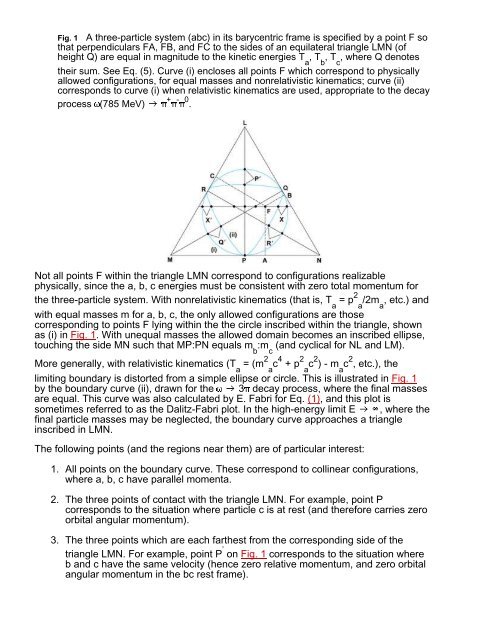Dalitz plot - F9
Dalitz plot - F9
Dalitz plot - F9
Create successful ePaper yourself
Turn your PDF publications into a flip-book with our unique Google optimized e-Paper software.
Fig. 1 A three-particle system (abc) in its barycentric frame is specified by a point F sothat perpendiculars FA, FB, and FC to the sides of an equilateral triangle LMN (ofheight Q) are equal in magnitude to the kinetic energies T a, T b, T c, where Q denotestheir sum. See Eq. (5). Curve (i) encloses all points F which correspond to physicallyallowed configurations, for equal masses and nonrelativistic kinematics; curve (ii)corresponds to curve (i) when relativistic kinematics are used, appropriate to the decay+ - 0process (785 MeV) .Not all points F within the triangle LMN correspond to configurations realizablephysically, since the a, b, c energies must be consistent with zero total momentum forthe three-particle system. With nonrelativistic kinematics (that is, T = p 2 a a /2m , etc.) andawith equal masses m for a, b, c, the only allowed configurations are thosecorresponding to points F lying within the the circle inscribed within the triangle, shownas (i) in Fig. 1. With unequal masses the allowed domain becomes an inscribed ellipse,touching the side MN such that MP:PN equals m :m (and cyclical for NL and LM).b cMore generally, with relativistic kinematics (T a= (m 2 a c4 + p 2 a c2 ) - m ac 2 , etc.), thelimiting boundary is distorted from a simple ellipse or circle. This is illustrated in Fig. 1by the boundary curve (ii), drawn for the 3 decay process, where the final massesare equal. This curve was also calculated by E. Fabri for Eq. (1), and this <strong>plot</strong> issometimes referred to as the <strong>Dalitz</strong>-Fabri <strong>plot</strong>. In the high-energy limit E , where thefinal particle masses may be neglected, the boundary curve approaches a triangleinscribed in LMN.The following points (and the regions near them) are of particular interest:1.2.All points on the boundary curve. These correspond to collinear configurations,where a, b, c have parallel momenta.The three points of contact with the triangle LMN. For example, point Pcorresponds to the situation where particle c is at rest (and therefore carries zeroorbital angular momentum).3.The three points which are each farthest from the corresponding side of thetriangle LMN. For example, point P ’ on Fig. 1 corresponds to the situation whereb and c have the same velocity (hence zero relative momentum, and zero orbitalangular momentum in the bc rest frame).















